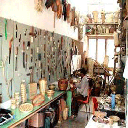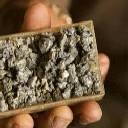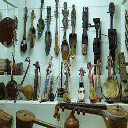Balrampur is a city and a municipal board in Balrampur district in the state of Uttar Pradesh, India. It is situated on the bank of river Rapti and is the district headquarters of Balarampur district. The name of this estate was derived from its founder Balram Das, who founded it in c.1600 CE. The city of Balrampur is famous for its association with Buddhism and Jainism. Balrampur town known for Balrampur Chini Mills, one of the largest sugar manufacturing and polluting industry in the country. The company has four sugar factories located in Eastern Uttar Pradesh (India) having an aggregate sugarcane crushing capacity of 29,000 tones crushed per day. Balrampur is well known for its ancient ruins making it equally popular among archaeologists, historians as well as tourists. Balrampur is situated on the banks of River Rapti. Balrampur district is a part of Devipatna division. Balrampur is located at 27.43° N 82.18° E. The city has an average elevation of 106 meters. The town is in foothills of Himalaya. Due to its location in the Gangatic plains and proximity to the Tropic of Cancer, enjoys a comfortable winter but a really hot summer. In the winters, the night temperature can go down to around 10°C and the day temperature to 20°C. October-November and February-March are almost always comfortable and sunny. Begining in April and continuing through June, it is extremely dry and the daytime temperature often reaches 45°C. In late June or early July, monsoon season brings torential rains and high humidity. As per the 2001 census, the population of the Balrampur is 21,824. Males constitute 52% of the population and females 48%. Balarampur has an average literacy rate of 58%, which is lower than the national average of 59.5. In Balrampur, 63% of the males and 37% of the females are literate.
The city was founded by BALRAM DAS after whom the state was named. The city had biggest Taluqdari in Oudh and rules by following rulers since 1777. The territory which the present Balrampur district covers was a part of the ancient Kosala kingdom.Sravasti was the capital of Uttara or North Kosala. Towards the Rapti River, a little north of Sahet, lies the ancient city of Mahet.Here Stupas reflect the Buddhist tradition and boast of the history of the monasteries in Balrampur. It is said that Mahavira Jain, the 24th Tirthankara of Jainism, 'influenced' this place. It houses the famous Shwetambar temple. The area covered by the district was a part of Bahraich Sarkar of Awadh Subah during the Mughal rule. Later, it came under the control of the ruler of Awadh till its annexation in February, 1856 by the British government, British government separated Gonda from Bahraich and it became a part of Gonda. After independence, Balrampur estate was merged with Utraula tehsil of Gonda district. July 1, 1953 the tehsil of Uttraulla was bifurcated into two tehsils, Balrampur and Utraula. In 1987 three new tehsils were created from Gonda Sadar tehsil, namely, Tulsipur, Mankapur and Colonelganj. Later, in 1997 Gonda district was bifurcated into two parts and a new district, Balrampur was born.


































































